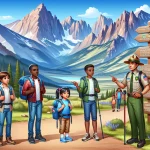From the steep, red rock walls of the Royal Gorge to the plunging waterfalls in Hanging Lake, Colorado’s canyons offer unique adventures, stunning vistas, and windows into the past.
In This Article
TL;DR
- The canyons of Colorado, carved over centuries by the Gunnison River and other waterways, provide unmatched outdoor recreation, from hiking and rafting to climbing and camping.
- Rich history and culture permeate Colorado's canyons, from ancient Puebloan cliff dwellings to Old West towns.
- Conservation efforts preserve these natural and cultural treasures for future generations.
Scenic Overview: Postcard-Worthy Beauty
With towering sandstone cliffs, rushing rivers, and evergreen forests, Colorado’s canyons showcase the state’s diverse natural beauty. The steep walls of the Black Canyon of the Gunnison National Park plunge over 2,700 feet, revealing rocky cliffs streaked with pink quartz and iron-rich pegmatite.
Further west, the Colorado National Monument protects sheer-walled, red rock canyons carved by the Colorado River. High-altitude canyons like Maroon Bells-Snowmass Wilderness offer alpine scenery, with glistening lakes backed by snow-capped peaks. Colorado’s canyons highlight the state’s scenic splendor from the deserts of Canyonlands to the San Juan Mountains.
There are many state and national parks to choose from, including Castlewood Canyon State Park, Eldorado Canyon State Park, Mesa Verde National Park, and Rocky Mountain National Park. All provide breathtaking and unforgettable vistas.
Thrills and Adventure for All Interests
Colorado’s canyons offer outdoor adventures for all interests and skill levels, from family-friendly hikes to heart-pumping whitewater. Raft the rapids of the Animas River near Durango or tackle the Class V rapids of the Crystal Mill section of the Cache la Poudre River. The steep trails of Hanging Lake and Bridal Veil Falls reward hikers with stunning waterfalls, while the Via Ferrata in Telluride offers rock climbing along safe, fixed routes. The canyons also provide mountain biking, camping, fishing, and more opportunities. With safety measures in place, these activities cater to novice and expert outdoor enthusiasts alike.
Windows to the Past: Cultural Riches
Beyond their natural beauty, Colorado’s canyons offer glimpses into the past through well-preserved historical and cultural attractions. Mesa Verde National Park safeguards over 600 cliff dwellings and archaeological sites left by the ancestral Puebloan people. At Dinosaur National Monument, see hundreds of dinosaur fossils embedded in an exposed sandstone wall.
Set against a stunning Rocky Mountain backdrop, the historic Victorian buildings of Telluride and Silverton transport visitors back to Colorado’s mining heydays. Colorado’s canyons intertwine natural splendor with cultural riches from prehistoric cultures to the Old West.
Conservation: Preserving the Canyons
Several conservation initiatives help preserve Colorado’s fragile canyon ecosystems and cultural heritage. The Rim Rock Drive improvement project at the Colorado National Monument improves road safety while minimizing environmental impact. Non-profits like the Black Canyon Conservancy and Friends of Dinosaur work to protect wildlife habitats and conduct scientific research.
Sustainable tourism practices, such as limiting group sizes and requiring permits for overnight stays, ensure continued public access while safeguarding the land. As stewards of these natural and cultural treasures, conservation remains vital to retaining the splendor of Colorado’s canyons for generations to come.
Four Seasons of Adventure
The canyons of Colorado offer unique seasonal adventures to match any interest or experience level. In winter, try ice-climbing frozen waterfalls or ski the champagne powder slopes of Telluride. As wildflowers bloom in spring and summer, explore colorful slot canyons by foot or book a whitewater rafting tour to beat the heat.
In fall, the golden aspens and cottonwoods contrast dramatically with red rock walls. Cooler fall temperatures make for pleasant hiking and mountain biking. Whether blanketed in snow or bathed in warm sunlight, the canyons of Colorado promise stunning vistas and outdoor recreation all year.
Canyons of the Ancients: Historical Significance
Various Native American tribes have inhabited Colorado’s canyons for over 10,000 years, leaving behind a rich cultural legacy. Ancient Puebloan sites like Mesa Verde National Park and Chimney Rock preserve the architectural heritage of ancestral Puebloan people, including intricate masonry dwellings built into alcoves high on canyon walls.
Ute tribal lands border Colorado’s western canyons, while Navajo communities help manage Canyonlands National Park and Mesa Verde. Archaeological discoveries reveal artifacts left by the Fremont, Ancestral Puebloan, Ute, Navajo, and other tribes who have called these canyons home. This long history imbues Colorado’s natural landscapes with added cultural depth and meaning.
Travel Tips: Making the Most of Your Visit
To fully experience Colorado’s breathtaking canyons, consider these travel tips.
Getting There
Denver and Grand Junction offer the closest major airports, while small regional airports serve gateway towns like Telluride and Durango. Shuttle services and scenic drives connect to most canyon destinations.
When to Visit
Spring and fall offer moderate temperatures for hiking and sightseeing. Summers draw crowds, so book accommodations in advance. Winters offer fewer crowds, but some areas become inaccessible.
What to Pack
Layer clothing for changing canyon weather and wear sturdy shoes for uneven terrain. Carry extra water and sun protection for desert hikes. Consider packing binoculars, field guides, and a camera.
Guided Tours
Consider booking guided rafting trips, 4WD tours, or ranger-led hikes and educational programs to maximize insights while supporting local businesses.
Why Visit? Breathtaking Beauty and Adventure
Colorado’s canyons showcase the state’s natural diversity at its finest, from towering sandstone walls to gushing waterfalls. These landscapes provide boundless opportunities for outdoor recreation, from family-friendly hikes to heart-pounding rafting. Beyond scenic vistas, they offer glimpses into the past through well-preserved archaeological and historical sites.
Thanks to thoughtful conservation efforts, generations can continue exploring Colorado’s canyons. Whether you are seeking outdoor adventure, cultural insights, or spectacular scenery, the Canyons of Colorado guarantee an unforgettable travel experience.
FAQ
What are the top things to see and do in the canyons of Colorado?
Some top attractions include hiking to waterfalls like Hanging Lake and Bridal Veil Falls, whitewater rafting on rivers like the Animas and Colorado, exploring ancient cliff dwellings at Mesa Verde National Park, and marveling at dinosaur fossils in Dinosaur National Monument.
What is the most accessible canyon to visit in Colorado?
The Colorado National Monument offers stunning canyon views, paved roads, and short, accessible hiking trails, making it one of Colorado’s most convenient canyons.
Where can I see fall colors in the canyons?
Many of Colorado’s canyons shine with golden fall foliage, especially aspen groves in Maroon Bells-Snowmass Wilderness and canyon maple trees in the Black Canyon of the Gunnison.
Are dogs allowed in Colorado’s canyons?
Leashed dogs are allowed in most areas. However, some trails, backcountry areas, buildings, and parts of Mesa Verde National Park prohibit dogs. Always check regulations before visiting.
How can I practice sustainable tourism in Colorado’s Canyons?
Follow Leave No Trace principles, stay on marked trails, pack out all trash, respect wildlife, avoid building fires, and consider offsetting your travel carbon footprint. Also, support local conservation groups and sustainable outfitters.






